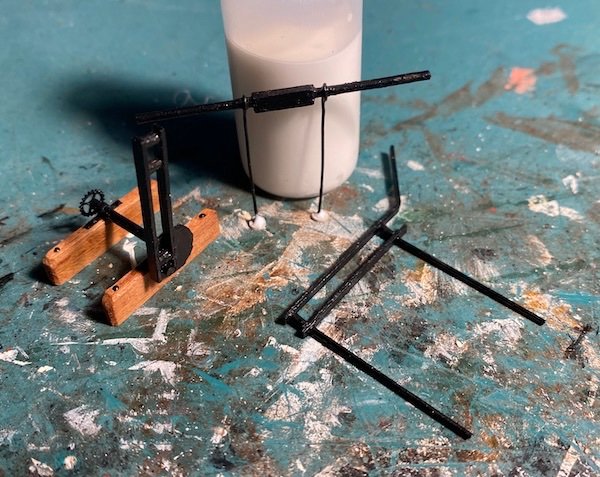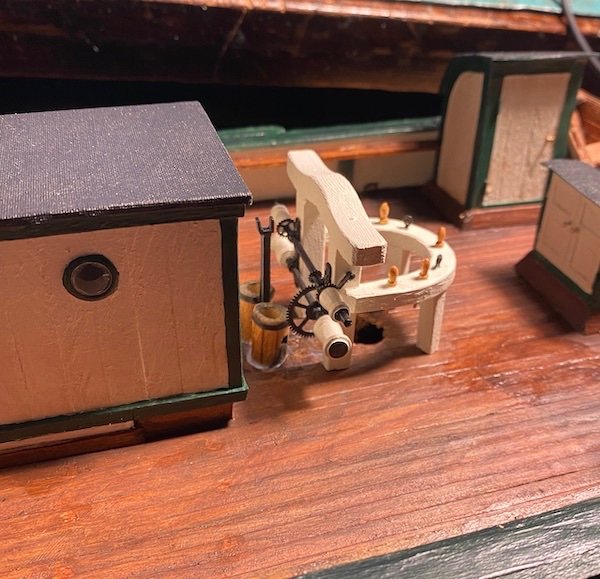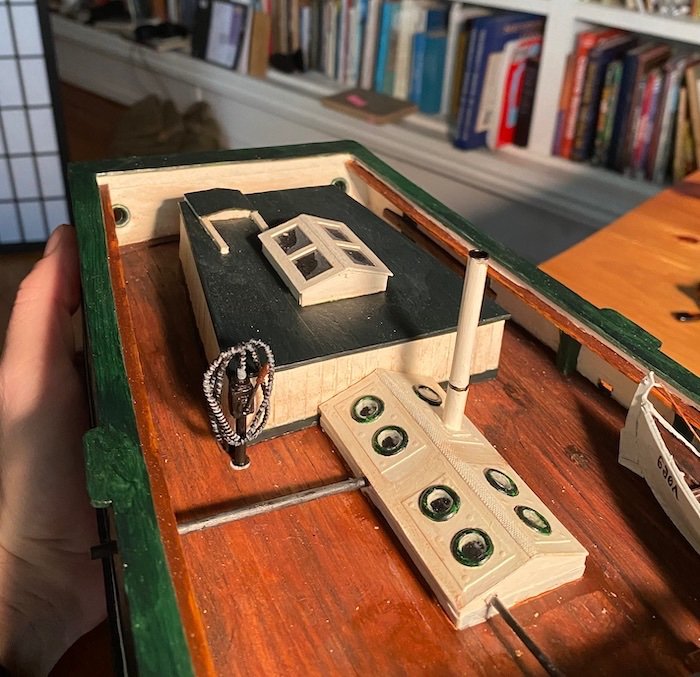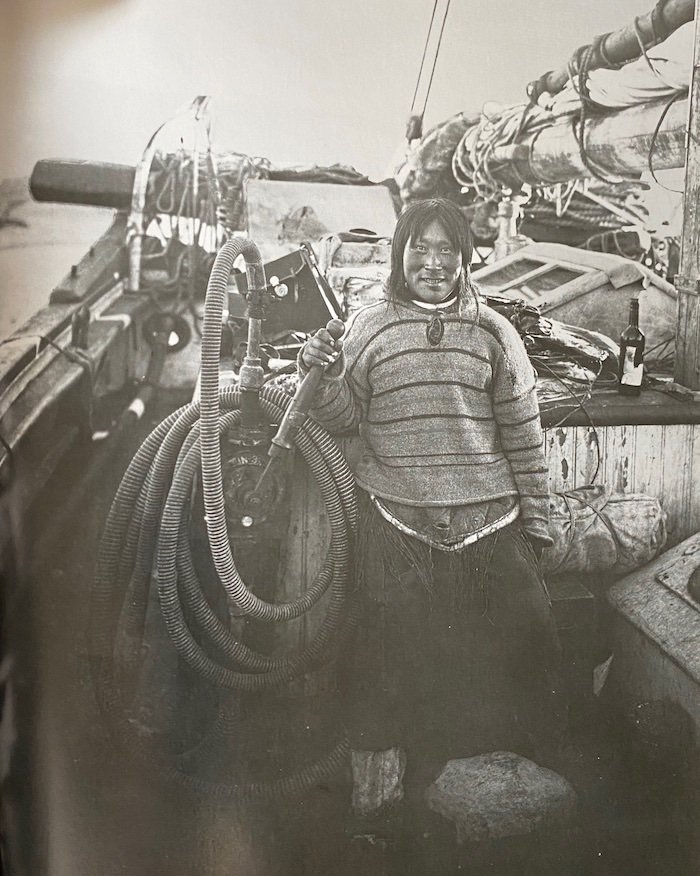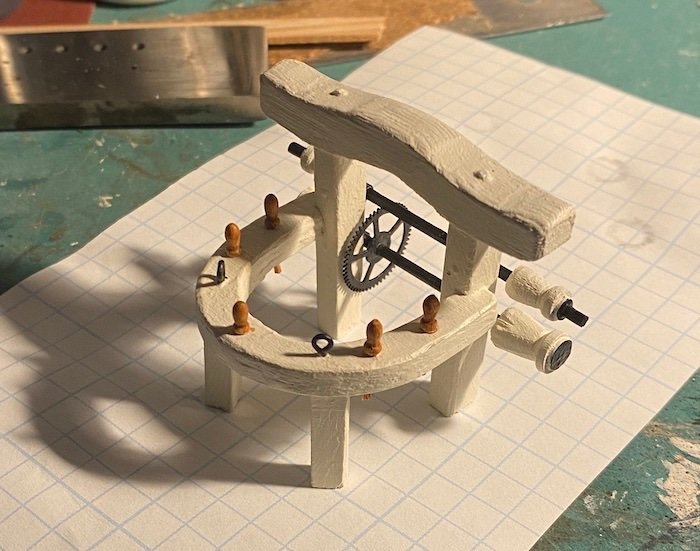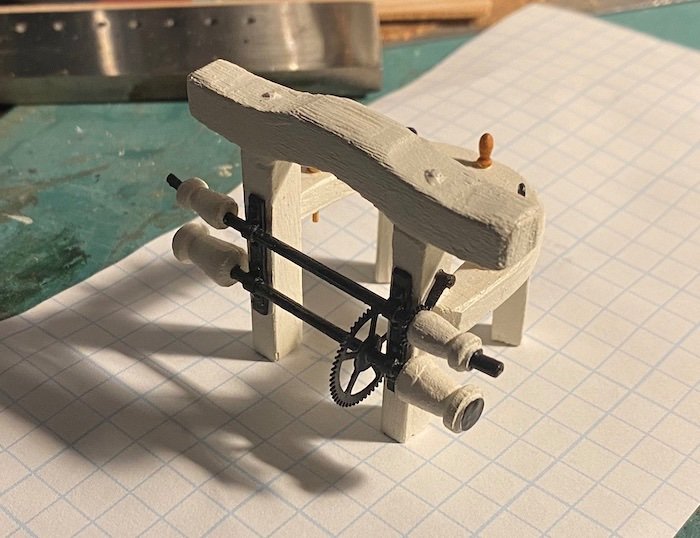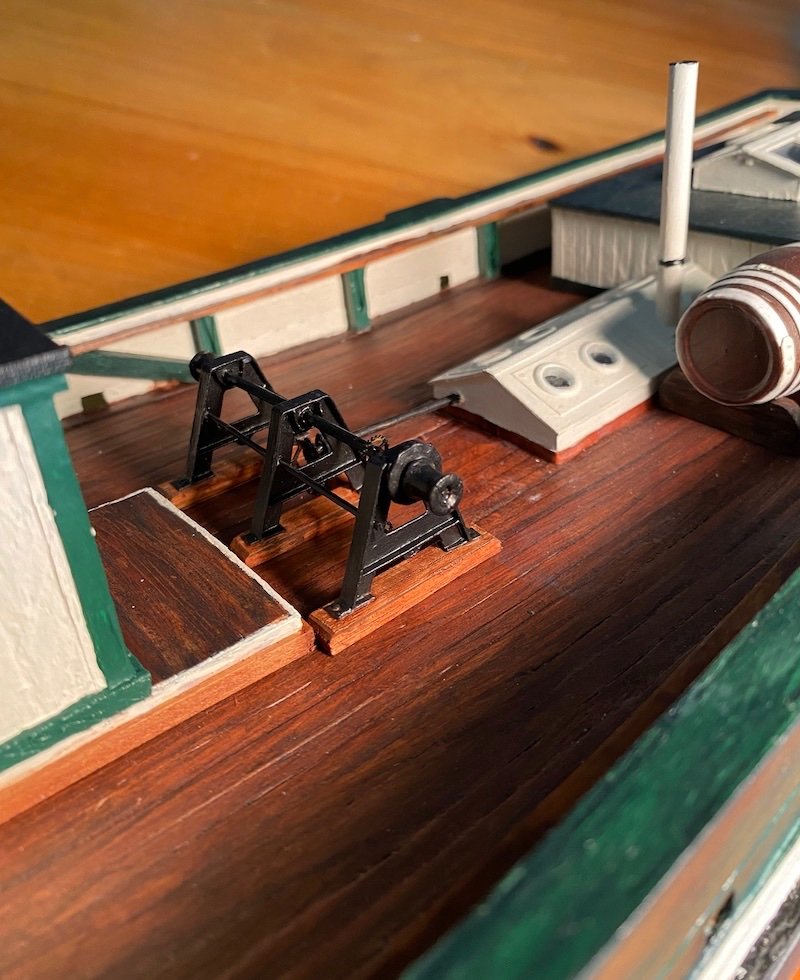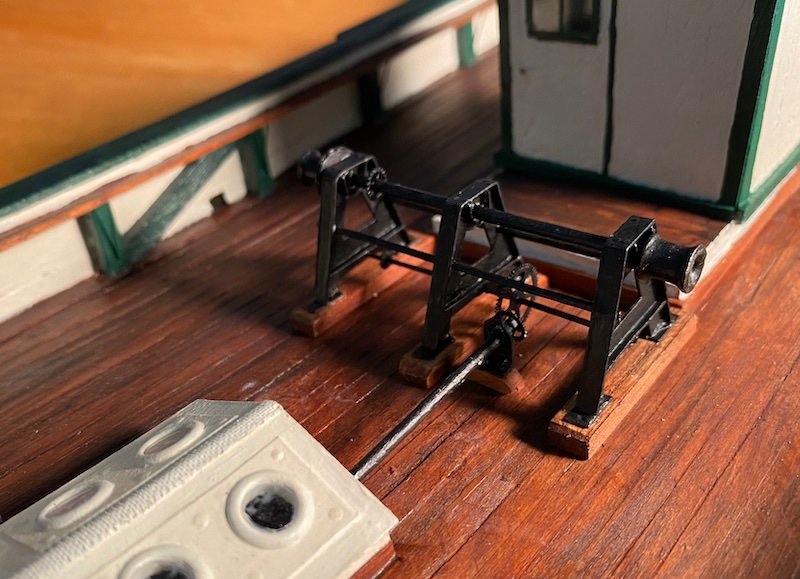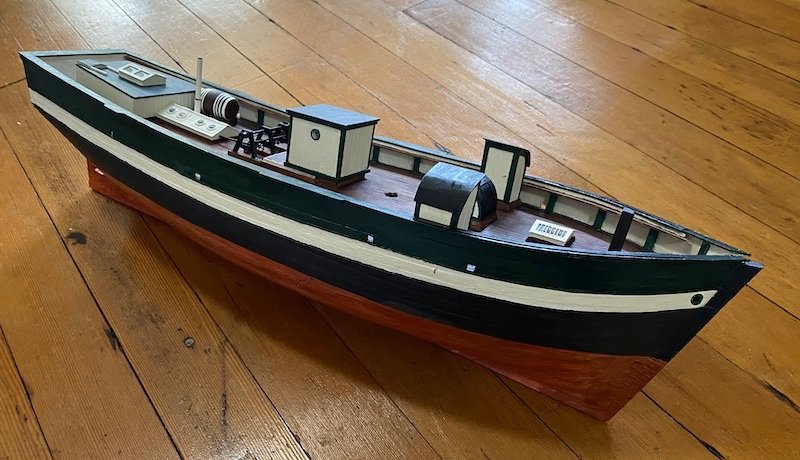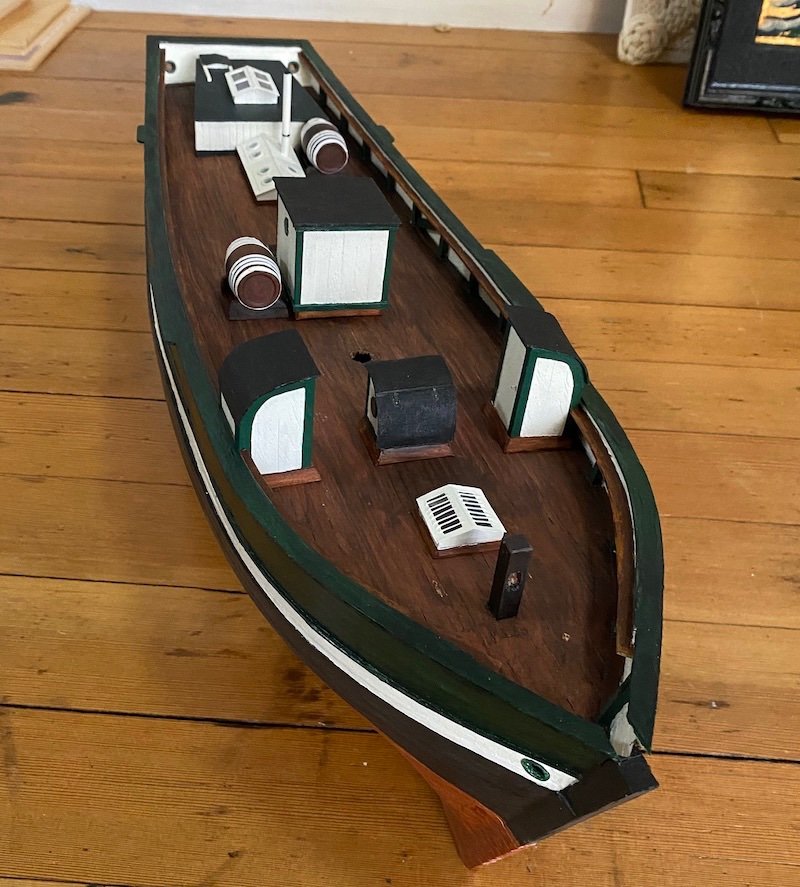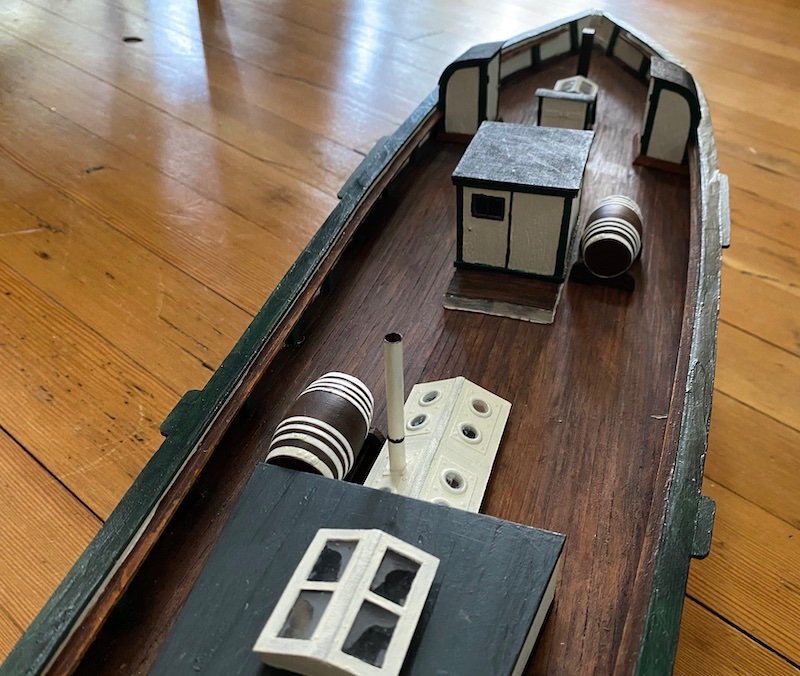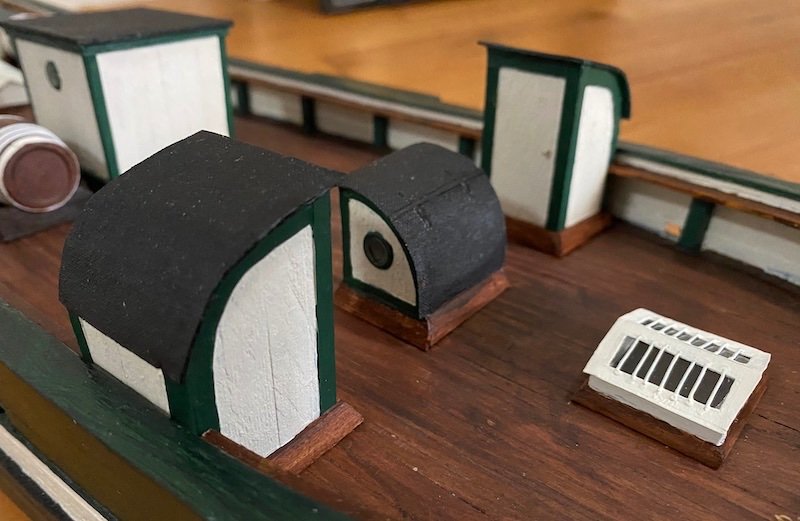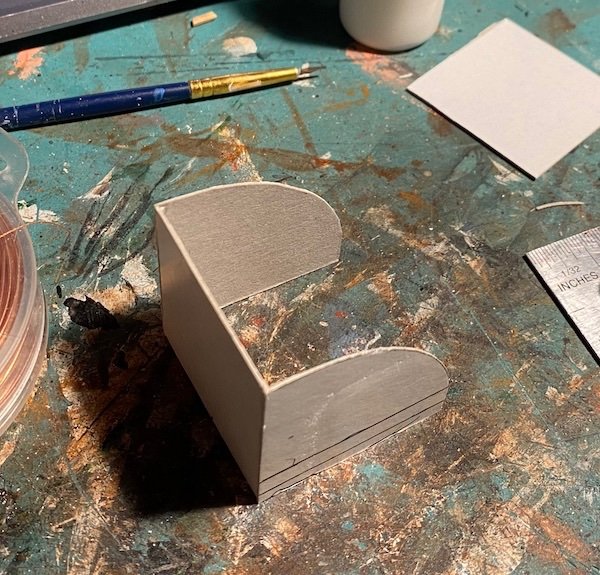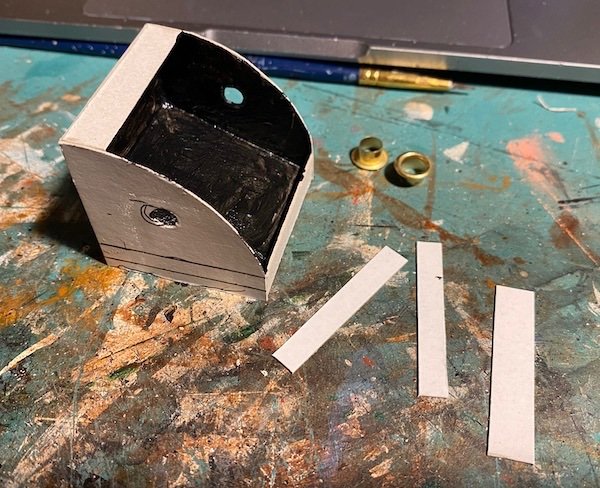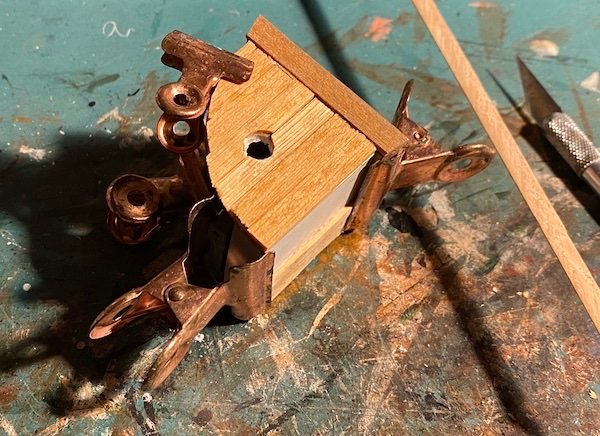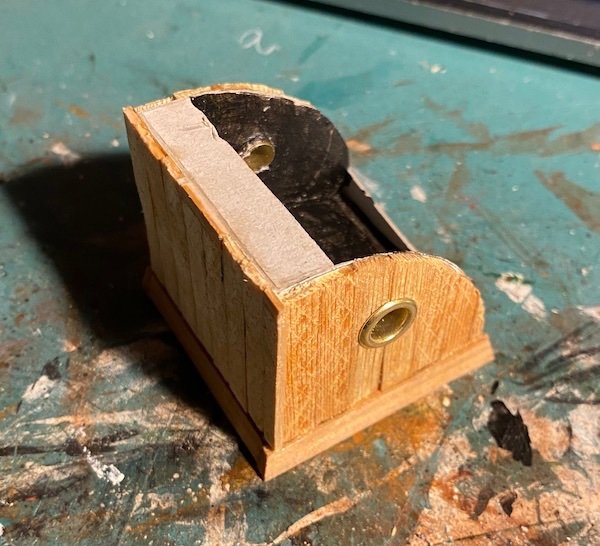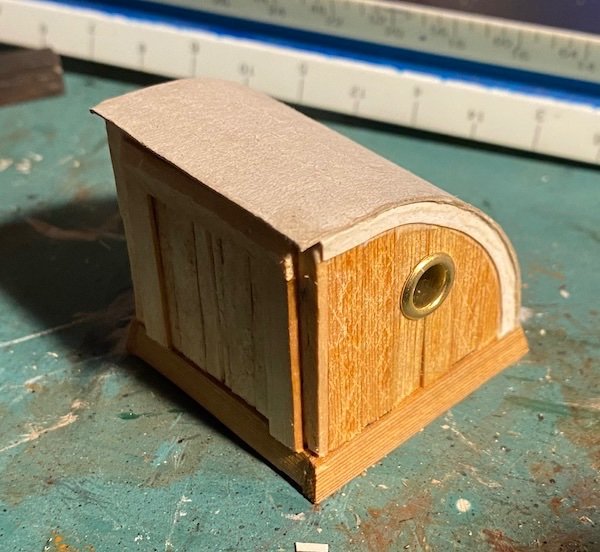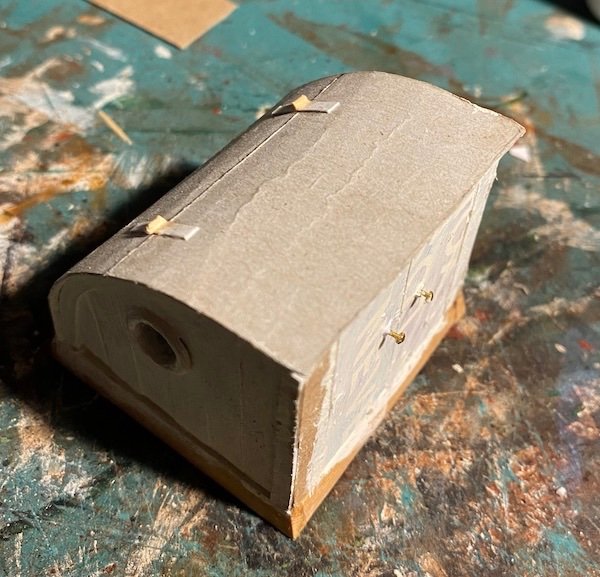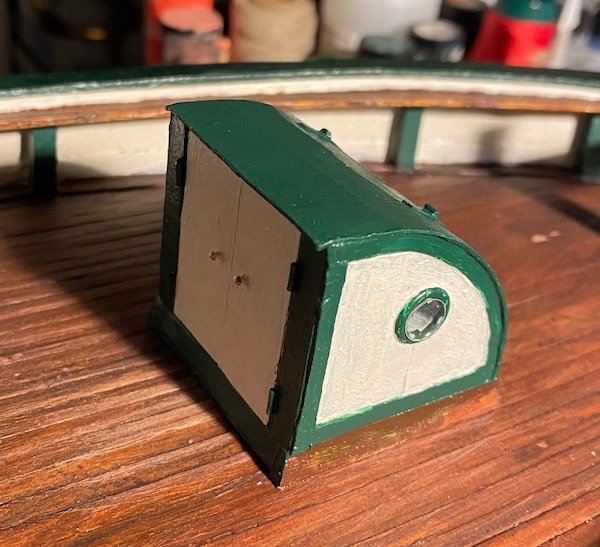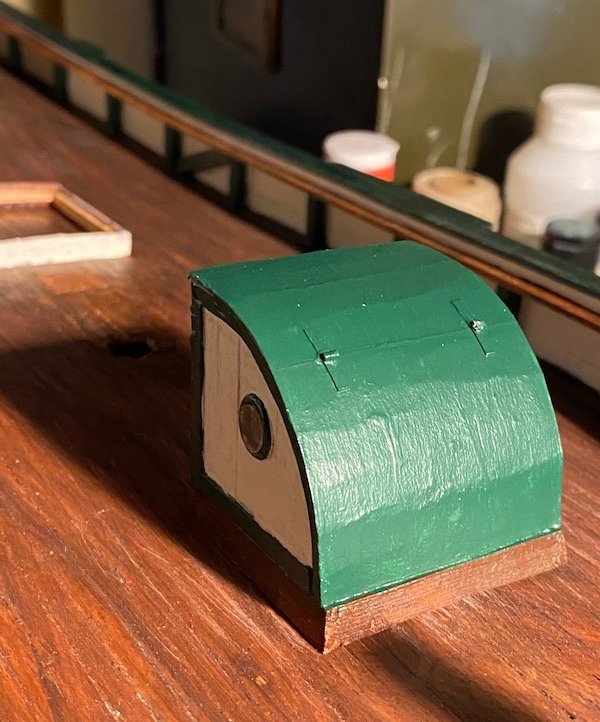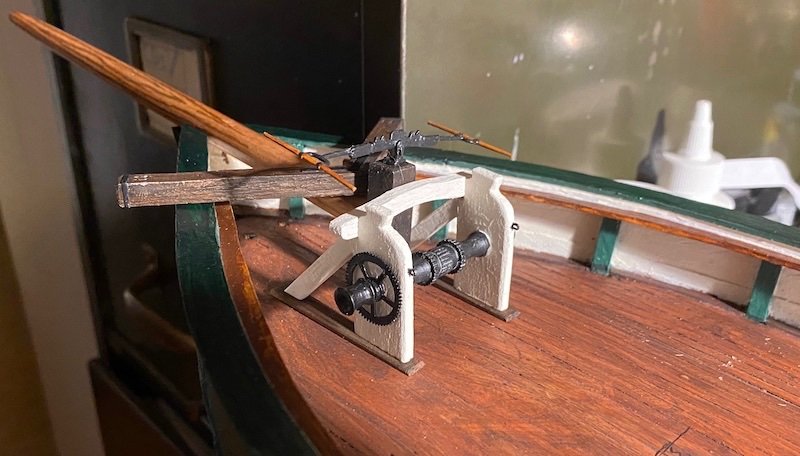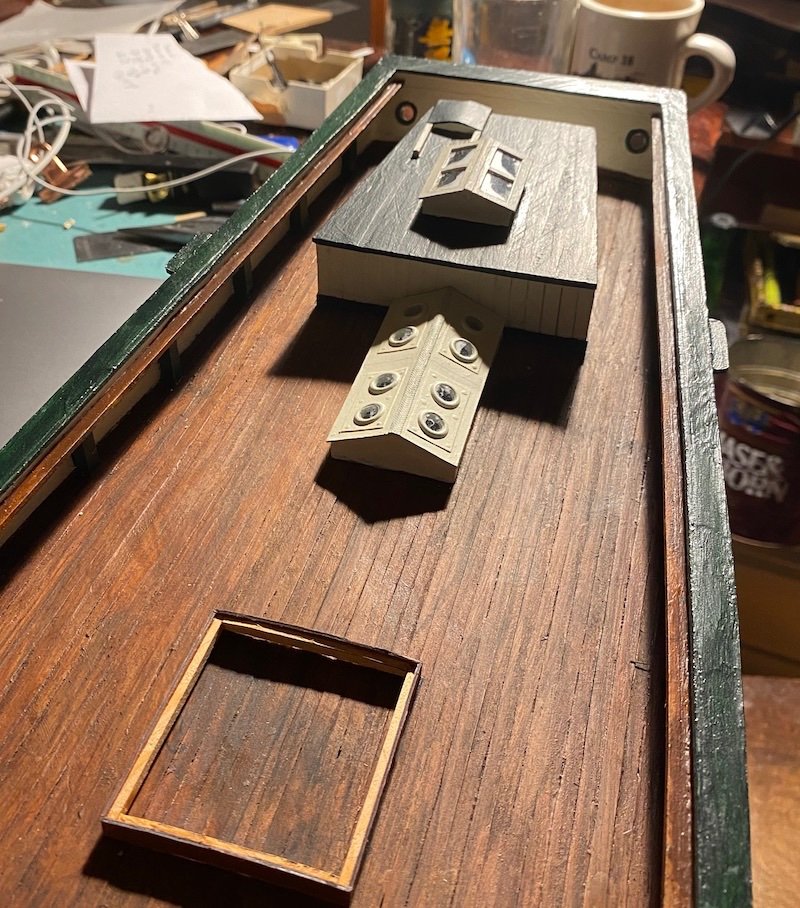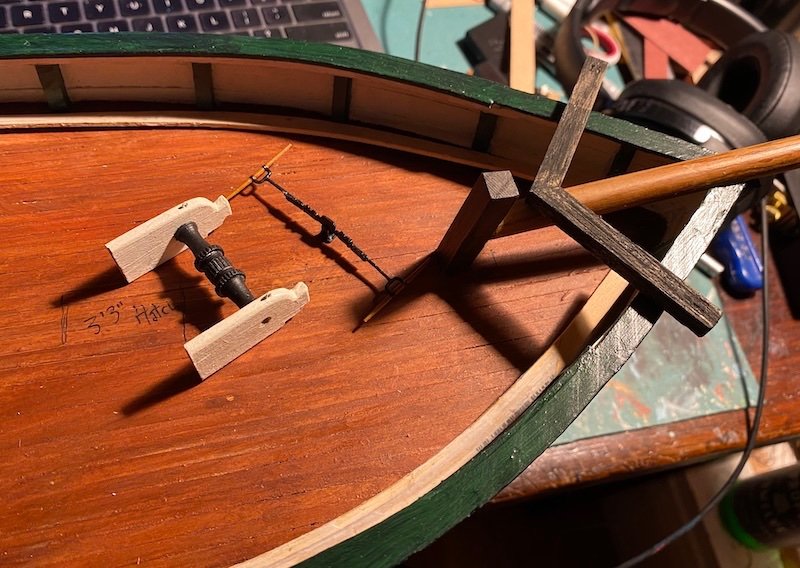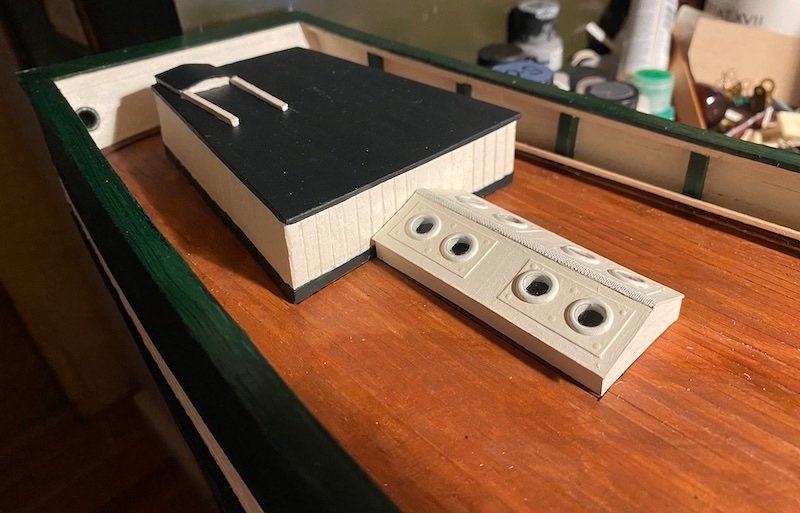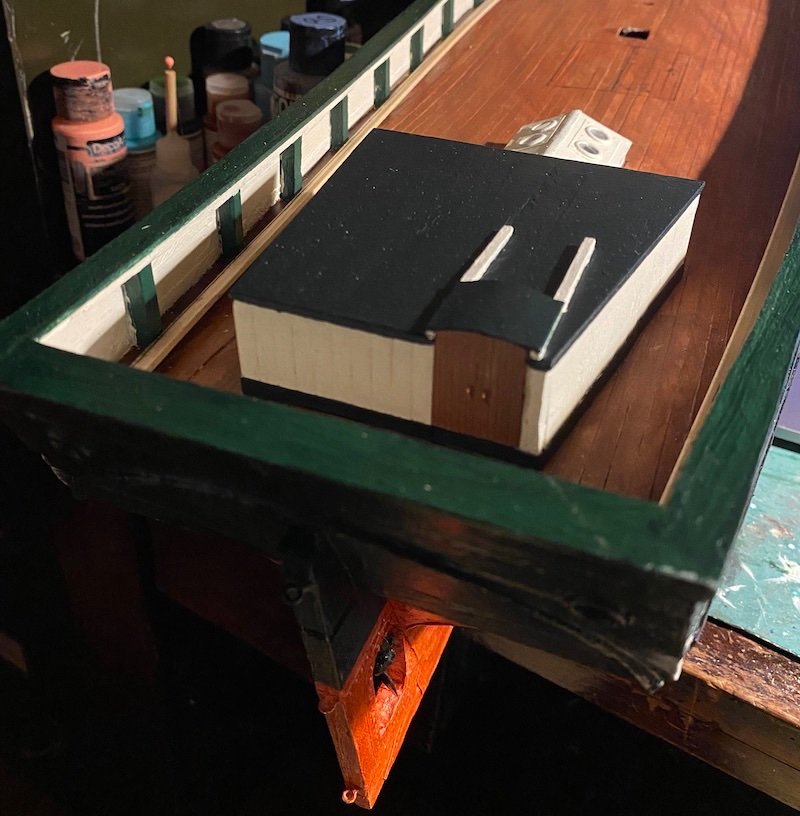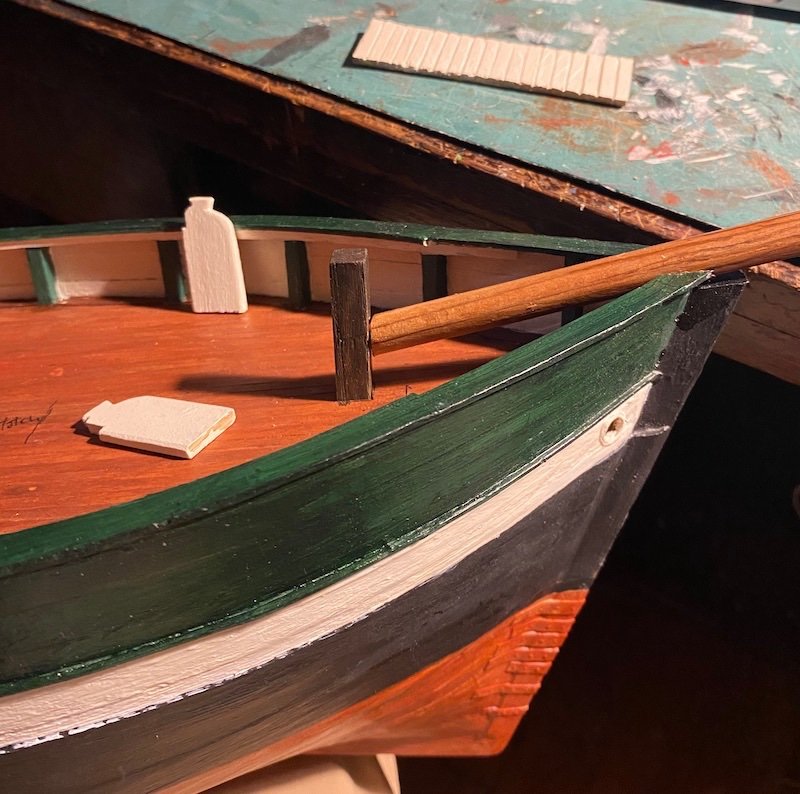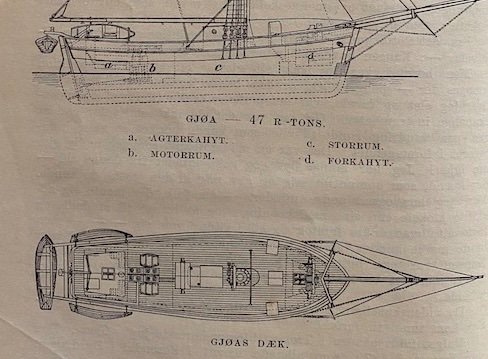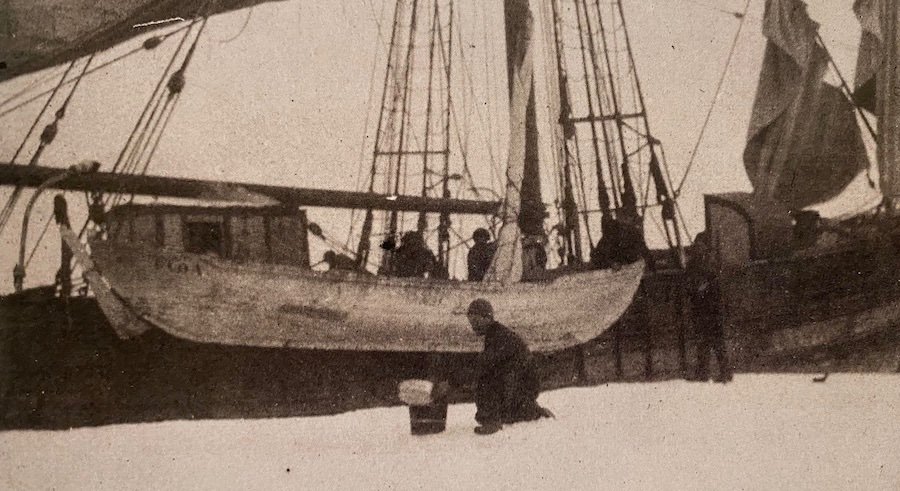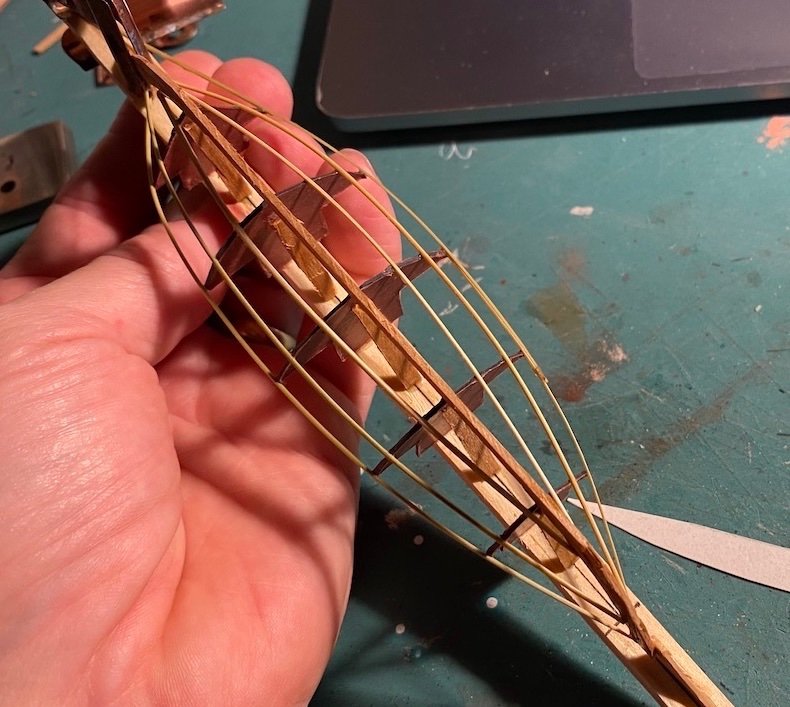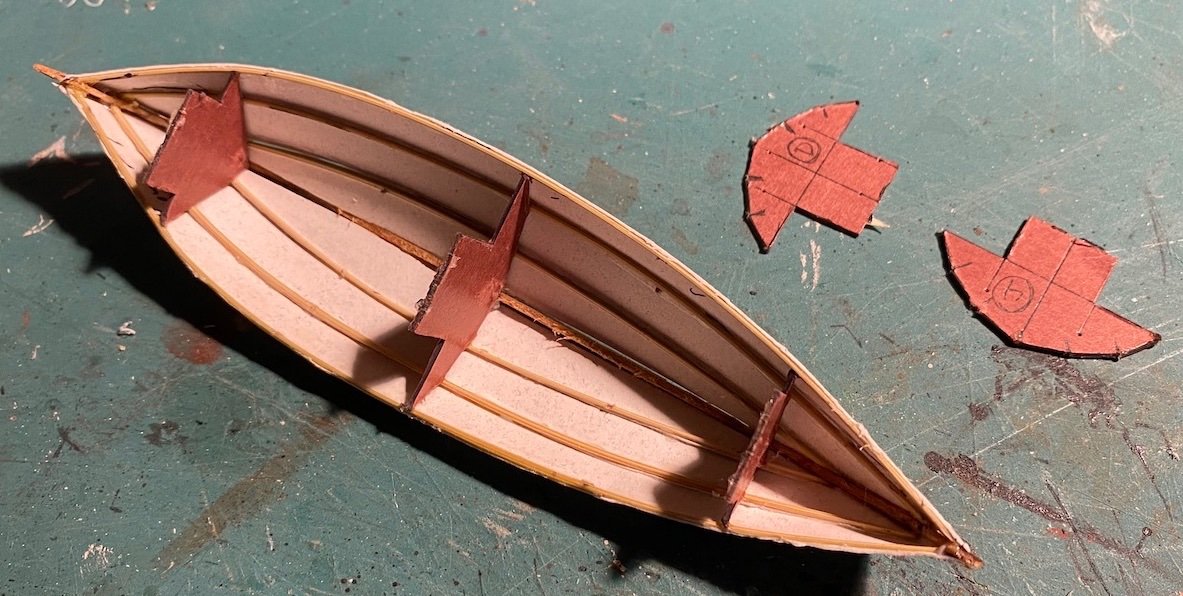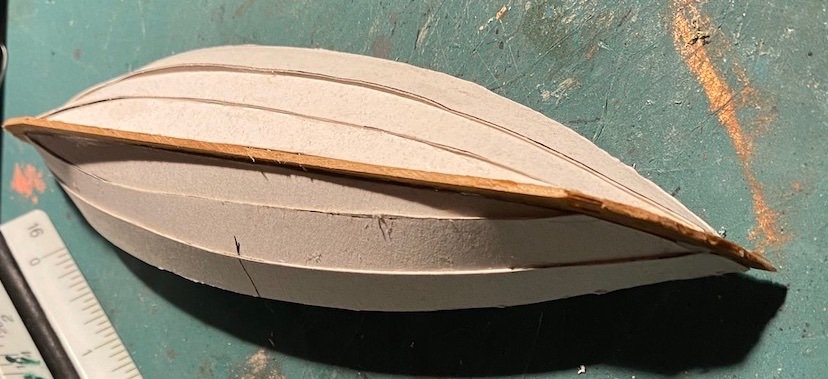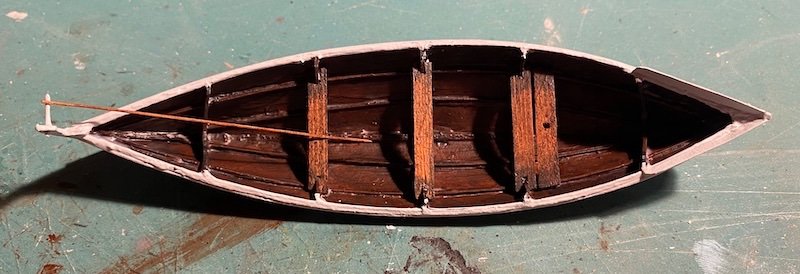-
Posts
447 -
Joined
-
Last visited
Content Type
Profiles
Forums
Gallery
Events
Everything posted by Harvey Golden
-
Here's the pump machinery underway, with the pump logs stepped with iron pivot bracket mounted (and corrected gearing on the winch). Thanks again for the photos Steve and Eberhart-- these have been a tremendous help. (Looks like the photos that came with the kit were made during the WPA-HAMMS survey of '36-'37...) -H
-
Dear Steve and Wefalck-- thank you both so much for the images and analysis of the Gjøa's machinery. These images are exactly what I was hoping for-- they answer a million questions. Looks like I missed the two smaller gears on the midship winch-- shouldn't be too hard to remedy. Attached is the pump as shown in the historic image above. Also shown: the exhaust pipe for the Dan motor (gray).
-
Can anyone identify this bit of machinery on the Gjøa? The image is from Roald Amundsen's Diaries, as issued by the Fram Museum, Oslo in 2017 (page 485). It was taken at King William Island (the middle of his NW passage transit)-- note the hose running through the stern hawse pipe; perhaps for loading water? Thank you!
-
I'll keep searching for old images-- I suppose at some point one must decide whether to put in the likely apparatus or leave unknowns omitted. Too bad she's now stripped down so much in terms of deck machinery-- It does make sense as she's now cleared for visitors. It looks like the aft winch has been moved back, and the galley has been re-positioned aft on the hatch to make it more accessible.
-
The mast's pinrail is completed, along with some of the attached machinery. The winch heads are hand-carved from dowel ends-- no lathe in my shop. Quite a few other little things to do before stepping the mast, but it's just around the corner. Next I'll tackle the pumps as best I can from limited information-- seems to be dearth of info as to how exactly they were set up; I don't even know what the big gear on the pinrail does or what it connects to, but photos show its presence.
-
Looks correctly (and quite perfectly!) built to my eyes. The WoodenBoat book series title "10 Wooden Boats you can Build" features this design (1995). The chine logs likely allowed for thinner planking and lighter framing; adapted to plywood (as in the book) would allow for a very light and easy to build boat (stitch and glue construction would preclude needing the chines, but would require more framing and/or thicker planking).
-
Thank you-- some very hard-to-find material there! The link to South East Asian boats is to his study of 'extra-European' boats-- covering the rest of the world. It doesn't seem to have the engravings (issued separately), but here they are for any interested: https://archive.org/details/essaisurlaconstr02pris/page/n11/mode/2up This is probably one of the finest world-survey of watercraft; I don't think anything since has come close to it, even despite its areas of weakness.
-
Thank you Steve! I don't have the best info on the pumps and their arrangement, so it will indeed be an interpretation. Photos of the Gjøa as she is today show her stripped down in this area (merely the stumps and no machinery), and the drawings I'm working from are a little thin or vague in this area. Several historic images will be of great help, though.
-
The aft windlass-- an iron structure-- is completed and installed. Made from wood, paper, and watch and clock gears. It was powered by the 3 h.p. Dan engine, hence the drive shaft projecting from the engine room skylight. A messenger chain ran forward from the port side to the pumps and forward windlass. This assembly still needs the chain linking the lower shaft to the upper. Some other details: scuppers as they appeared during the voyage, iron braces for the pinrail, and lastly a view of the whole as she sits today.
-
Ending the year with more deck houses installed, including the two 'outhouses' (dry-fitted, so a tad crooked yet). The galley and a bow skylight are in place, and also a few details such as the stack from the engine skylights, two water casks (positioned as-per historic photographs). The barrels are just 'craft-store' kitsch with the carved hoops sanded off and replaced with steel (paper, actually) hoops. The companionway got a book-cloth cover (painted black) to match the galley's roof. I've also started cutting the scuppers in the bulwarks . . . hard to tell how many there were from old photos, and the photos taken of the ship at San Francisco's Golden Gate Park show many changes over the years. They were definitely of a different form than the Gjøa has now (one is visible in the upper photo, to the right). Anyhow, here she is to greet the new year:
-
I use a lot of card & paper on my scratch models-- often just stock pulled from the recycling bin, so I don't even know the types, etc. Naturally, I often have the curving issues you show. I often will glue on strips of wood to straighten them out-- sort of like deck beams, glued to the upper face of the bulkheads. This straightens (and strengthens) them and also provides a thicker base for gluing a deck down. That's just my solution; hopefully a true connoisseur of things paper can chime in. Best, H-
-
The forward companionway: Here's a bit of the process I'm using in making the deck structures... I use card stock to form the shape of the structure-- very easy to work with. Dimensions are slightly under, as this will all be sheathed in wood strips. Almost done with the card foundation-- just some reenforcing strips to add. The interior is blackened and the holes for the deadlights are punched. Sheathing in cedar strips. The sills are also of cedar, beveled as shown. Deadlights in and sheathing finished. Roof of card glued on and some initial paper trim placed. Hatch is framed. . . and later removed as I didn't like it, and there wouldn't be a header, as the roof was hinged and doors ran to the very top... All trim in place; hinges added to roof (and joint scored); hatches in place with brass knobs. Painted and in place. The white glue in the deadlight should dry and disappear as it dries. Yes the roof is rumpled a bit. I don't know what the original material was, but I suspect either sheet metal or perhaps more likely cross-planked and then canvased. I might scratch those hinges off and cover it with book cloth. . . not sure yet. FWIW, I like the rumpled look. H-
-
Dear Steve, I saw your project just the other day-- looking good! We seem to be roughly at the same stage. To be honest, I didn't even notice the lines attached to the tiller in the lines published with Amundsen's account; the plans I'm building from are from the 1930s Historic American Merchant Marine survey, and they don't show the lines. I suspect (but don't know) that the lines would be to set the rudder at desired deflect instead of being used to actually control the vessel moment to moment. There is a compelling photograph, though posed, about 20 years after the expedition that may shed light on this: (second image down) https://amundsen.mia.no/resource/1903-1906-gjoa-ekspedisjonen-gjoa/ Question is: Is the master goofing or showing how it's done? As she sits now in Oslo, the Gjöa does have the steering lines rigged to the tiller (attached to iron stanchions at the rear corners of the house). All the best, Harvey
-
This looking very nice! The steering oar is definitely astern, and wouldn't be switched end-to-end when shunting (a form of tacking), as symmetrical hulled multihulls had dedicated bows and simply tacked. The end shapes look good-- not sure to what extent anyone knows what the original voyaging canoes actually looked like (the Hoku'lea is conjectural). The upper painting in your above post is of a Tahitian type, which is fairly well documented.
- 174 replies
-
- Waa Kaulua
- bottle
-
(and 1 more)
Tagged with:
-
Recent Progress: The nearly full-length pintails have been installed. These are glue-laminated to proper bend, then attached-- a bit of a clamping nightmare. The winch been held up due to not having any suitable gears laying about; a little 'mixed-bag' of clock parts from eBay solved this issue, though some smaller ones are still en-route (The gear drives a messenger chain to the pumps and a another pair of winch heads further aft). The king post was a lovely fit through the deck, and while admiring my incredible workmanship, I dropped it all the way through, never to be seen again, hopefully. A drop of glue followed it up so it wouldn't rattle and remind me of my stupidity. The new one is pretty nice, though. More of the winch mechanism will follow, as well as cap-rail re-enforcements, etc. I've also go the mast made (tapered and painted)-- from a 1/2" poplar dowel. No lathe here, nor any better ideas than hand-turning it on a bench sander. The chain plate channels have also been added (a pair on each side of the cap-rails). Several more deck houses and apertures to make, and other odds and ends and then the rigging will begin in earnest.
-
Looks like an interesting project! If you can find Haddon & Hornell's "Canoes of Oceania" or Dodd's "Polynesian Seafaring," you'll see the incredible variety of Pacific sailing canoes in great detail. The variations of the word Vaka (waka, va'a, wa'a, waga, etc. ) are essentially all the same word, just with regional accents and/or people from different backgrounds and 'ears' putting it into writing, thus creating these orthographical spellings. Specific to Hawaiian canoes-- a copy of Tommy Holmes' incredible book (I forget the name) would undoubtedly smooth the way and further inspire. Looking forward! H-
- 174 replies
-
- Waa Kaulua
- bottle
-
(and 1 more)
Tagged with:
-
Counterpoint: Greedy grave robber (and investors).
-
Some thoughts on splotchy irregularities, etc... You are looking for solutions to fix this, but the solution might be an aesthetic decision. If you are going for the brand-new Canoa de Rancho factory show room look, splotchiness may well be a problem worth fixing. But these were work boats built and maintained by less than affluent fishermen for functionality above all. A bit of wear, repair, and splotch here and there can effectively convey the craft's humble existence-- if done well, it will breathe life into the model.
- 286 replies
-
Lots of progress-- comparatively, anyhow. Some Bluejacket fittings showed up, so more work on the windlass and catheads. The hand cranks are situated on the top of the bitt, so I had to make a new base with pivot (The Bluejacket winch is for a side mount). I also had to lengthen the handles a bit with some micro-woodworking involving mortise and tenons on two tiny scraps of wood tenoned into the ends of the center piece. (The bent laminated unpainted strips are the full-length pintails still waiting to be mounted up near the cap rail.) Many, many more details to come for this area of the ship. I've also built the deck house and engine room skylights. The house is planked (cedar veneer) glued on heavy paper (The house's skylight is in progress). The skylight is paper with perfectly sized brass grommets I had leftover from another project. The glass is from packaging material, and it was my lucky day to find out that a standard hole-punch made the perfect size panes for the grommets. Need a little puttying at the connections of the deck and house and skylight. . . Not sure if the companionway had drop-boards or doors . . . the model will have doors. (Edited: The Plans show doors! ...My mistake (and correct solution).
-
Some recent progress: The king post and bowsprit are dry-fitted. I'm starting to make cabin sides and other deck furniture (the windlass supports are shown). There are shelves inboard of the bulwarks that have been perplexing me for a while, but I've finally settled on laminating them from fine strips instead of scarfing in the curves and fairing-- a matter of getting a plank to bend against its width. These aren't fitted or shown, but should appear with the next update. Also visible in the photo is some iron strapping set around the stem as ice protection. These aren't on the Gjøa today, but are visible in historic images taken while she was in San Francisco. They are made from paper with dots of glue for drift heads. Note on the bowsprit: I've doubled the 'grain' with a felt-tip marker to be more in scale (compare left-to-right).
-
Not much progress, though a bit of a breakthrough with regards to the Gjøa's boats. It seems the kits for this ship have a skiff and two prams with them, and the drawing of the Gjøa in Amundsen's own published popular account of the voyage shows the skiff and two prams as well (below). But in the recently published "Roald Amundsen's Diaries" (Fram Museum, 2017), a historic photo shows what I naively thought was a whaleboat with "Gjøa" painted on its side. A closer look at the rudder made me think it may be a Norwegian local type, and it sure resembles an Oselvar type, not unique at all to Hardanger, where Gjøa was built (detail below from pg. 23). The Oselvar seems to be painted (who knows what color!), and has what look like added wash-strakes forward. Anyhow, it seems the Gjøa's true compliment of boats on the famous voyage was: 1 pram, 1 oselvar, 1 skiff (which Amundsen refers to as a dory), and a canvas canoe that is mentioned and appears in some images. So... from the drawing at https://www.oselvarverkstaden.no/historia/ I tried to fill the ledges of the lower ribands to make the model appear more like the lapped-strakes of the original in the inside, but it clearly needs more. Perhaps I should have snipped-out the bamboo ribands to achieve this. . . live and learn, fill and patch!
-
I was wondering about the colors-- seems all the images have been B & W. The image from 1934 is likely hand-colored, but it sure captures the mottled look, whatever colors they may be. Seems like a light base color, and sponging on a brown and/or blackish wash might do the trick. I'm very much enjoying this project! (I liked your last one too, and immediately regretted not going to Xochimilco when I was down there in April). Best, Harvey
- 286 replies
About us
Modelshipworld - Advancing Ship Modeling through Research
SSL Secured
Your security is important for us so this Website is SSL-Secured
NRG Mailing Address
Nautical Research Guild
237 South Lincoln Street
Westmont IL, 60559-1917
Model Ship World ® and the MSW logo are Registered Trademarks, and belong to the Nautical Research Guild (United States Patent and Trademark Office: No. 6,929,264 & No. 6,929,274, registered Dec. 20, 2022)
Helpful Links
About the NRG
If you enjoy building ship models that are historically accurate as well as beautiful, then The Nautical Research Guild (NRG) is just right for you.
The Guild is a non-profit educational organization whose mission is to “Advance Ship Modeling Through Research”. We provide support to our members in their efforts to raise the quality of their model ships.
The Nautical Research Guild has published our world-renowned quarterly magazine, The Nautical Research Journal, since 1955. The pages of the Journal are full of articles by accomplished ship modelers who show you how they create those exquisite details on their models, and by maritime historians who show you the correct details to build. The Journal is available in both print and digital editions. Go to the NRG web site (www.thenrg.org) to download a complimentary digital copy of the Journal. The NRG also publishes plan sets, books and compilations of back issues of the Journal and the former Ships in Scale and Model Ship Builder magazines.

